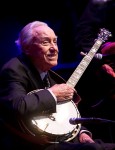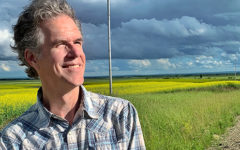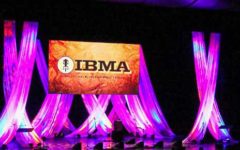Pete Wernick, the estimable Dr. Banjo, has sent along a three-part report compiled during his attendance at last week’s Bill Monroe Centennial Celebration in Owensboro, KY. They were adapted from comments he posted to the internal IBMA email discussion list. This second part regards a statement Pete read on September 13, 2011.
 As a preface, I’ll point out that it has long been a peeve of mine (and many others in the bluegrass world) that Earl Scruggs has not been given his due as a major driving force in the development and popularity of bluegrass music. This issue can and likely will be debated for a long time, but the more I learn about bluegrass history, the more I see that his contribution has been minimized by people who focus instead on Monroe – as the “father” (which I do think Monroe was) of bluegrass, and as the one focal point of the entire scene.
As a preface, I’ll point out that it has long been a peeve of mine (and many others in the bluegrass world) that Earl Scruggs has not been given his due as a major driving force in the development and popularity of bluegrass music. This issue can and likely will be debated for a long time, but the more I learn about bluegrass history, the more I see that his contribution has been minimized by people who focus instead on Monroe – as the “father” (which I do think Monroe was) of bluegrass, and as the one focal point of the entire scene.
Nowhere has this been more obvious than at the International Bluegrass Music Museum – until last Tuesday. Of course this year is exceptional, but the Monroe focus of the museum has long been evident, and while the other greats of bluegrass are present in different places, the contributions of Scruggs, the Stanleys, Jimmy Martin, and so many others, somehow appear quite secondary.
In a recent conversation with Museum Director Gabrielle Gray, I made the case for a public statement to be made to help righten this wrong. She agreed that a statement should be made, and made in Earl’s presence on his rare visit to Owensboro. I wrote up a sample statement, and a few days later, Gabrielle surprised me by asking me to deliver it.
As a great devotee of Mr. Scruggs, I accepted that honor and responsibility, and consulted with others to help me hone it to say it right and with respect to all concerned. Among those I thank for their help are Fred Bartenstein, Kitsy Kuykendall, and Steve Martin.
Here’s the statement, read on Bill Monroe’s birthday, Sept. 13, 2011, in the auditorium of the Riverpark Center, as part of the Legends Recognition Ceremony, with 66 of our finest seated on the stage and a good-sized audience:As you all know, we are here thanks to the wisdom, work, and vision of the International Bluegrass Music Museum, in the same building as that amazing institution, almost twenty years old now.
Some people might look at the museum this year and think, understandably, it is sort of the “Bill Monroe Museum.” Given this very special year, we hope everyone understands and is on board with the obvious emphasis lately. And of course we all know how proud Bill Monroe was of being from Kentucky – not far from right here – and named his band after Kentucky, which is what gave our music its name.
But… There is another individual, without whose contribution I doubt we would all be here celebrating this momentous birthday today at the International Bluegrass Music Museum…
A man who, starting at age 21, brought a new fire to Monroe’s music. It was more than “the sound of a banjo”, which had already been a part of Monroe’s music – it was a miracle of what human fingers could do on a musical instrument to electrify listeners. It was a perfect match for Bill Monroe’s music – strong, clear, smooth, clean and honest, and filled with the intense fire, beauty, and pride of the South, for all to hear.
It reached New York (Weissberg, Grisman, Fleck), West Virginia (Don Stover), Missouri (Doug Dillard, John Hartford), California (Alison Brown, Steve Martin). They all became part of bluegrass music.
The bluegrass sound as we know it today was complete as of December, 1945. Some might call this new sound the “rocket booster” that took bluegrass beyond the American South… to the whole country… overseas to Europe and Japan, and to the stars, for all time.
We are so proud he is here as part of this event, 66 years later.
This statement, cleared in advance by the Director of the IBMM, and delivered at her invitation, to a highly significant gathering and witnessed by 66 living legends of bluegrass, strikes me as symbolic of an important change of direction and attitude. I hope this lead is followed by historians and commentators henceforth, as it’s long overdue.
Yes, Bill Monroe earned his title, the Father of Bluegrass, not just by being the first bluegrass bandleader, and bringing together the team that put the bluegrass ship into orbit, but by acting paternal, in the role of “father” to the music and its practitioners, world-wide, for his whole long and illustrious life.
But it’s no less true that the stunning appeal, worldwide recognition, and longevity of bluegrass would not have happened without the spark added to the mixture by Earl’s banjo… a sound that was there not only at the beginning of “bluegrass as we know it,” but for a remarkable professional music career spanning two-thirds of a century, even longer than Monroe’s.
That there will be some debate about this for years to come will not surprise me, but I think there has developed a consensus that it took these two men to “make it happen.” There’s no doubt that the Stanleys, McCourys, Osbornes, Jimmy Martin, Lester Flatt, J.D. Crowe, Doc Watson, Doyle Lawson, the list goes on, have made irreplaceable contributions to the development of bluegrass music and the community that sustains it — but how much might any of post-1945 bluegrass history happened without both Bill and Earl? The Big Bluegrass Bang, if you will.
That that this statement was part of the Bill Monroe Centennial Celebration gives me great satisfaction — a highly deserving man has received a missing part of his proper due. It was the honor of a lifetime for me to deliver it.







